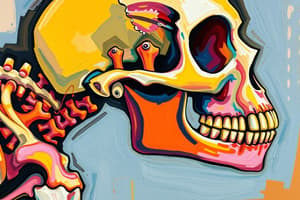Podcast
Questions and Answers
Match the following types of cartilage with their composition:
Match the following types of cartilage with their composition:
Hyaline cartilage = Predominantly collagen fibers Fibrocartilage = Predominantly collagen fibers with thick bundles Elastic cartilage = Predominantly elastin fibers Articular cartilage = Lines the surface of articulating bones
Match the following methods of cartilage formation with their descriptions:
Match the following methods of cartilage formation with their descriptions:
Interstitial growth = Chondrocytes within lacunae divide and secrete new matrix, expanding the cartilage from within Appositional growth = New chondrocytes and matrix are added on the surface of existing cartilage
Match the following bone components with their characteristics:
Match the following bone components with their characteristics:
Osteoblasts = Bone-forming cells that secrete matrix Osteocytes = Mature bone cells that maintain bone structure Extracellular matrix of bone = Mainly composed of collagen fibers and calcium salts Blood supply in bone = Well-vascularized to support metabolic activity
Match the following bone types with their descriptions:
Match the following bone types with their descriptions:
Match the following facts about bone and cartilage with their correct statement:
Match the following facts about bone and cartilage with their correct statement:
Match the following functions of cartilage with their descriptions:
Match the following functions of cartilage with their descriptions:
Match the type of cartilage with its primary location:
Match the type of cartilage with its primary location:
Match the component with its role in the cartilage extracellular matrix:
Match the component with its role in the cartilage extracellular matrix:
Match the cell type with its description:
Match the cell type with its description:
Match the characteristic with the correct type of cartilage:
Match the characteristic with the correct type of cartilage:
Match the function with the corresponding type of cartilage:
Match the function with the corresponding type of cartilage:
Match the structural feature with the correct type of cartilage:
Match the structural feature with the correct type of cartilage:
Flashcards are hidden until you start studying




